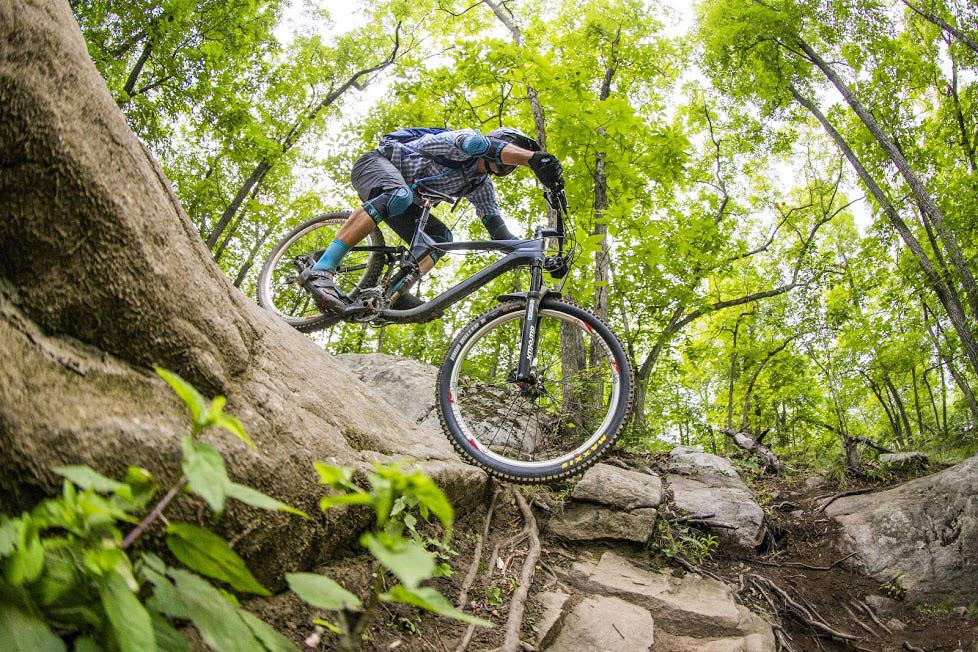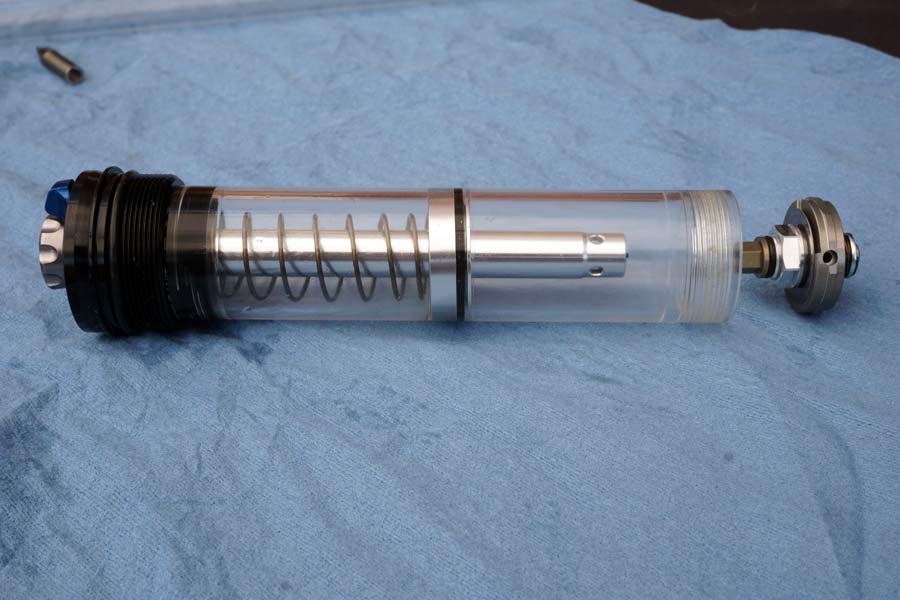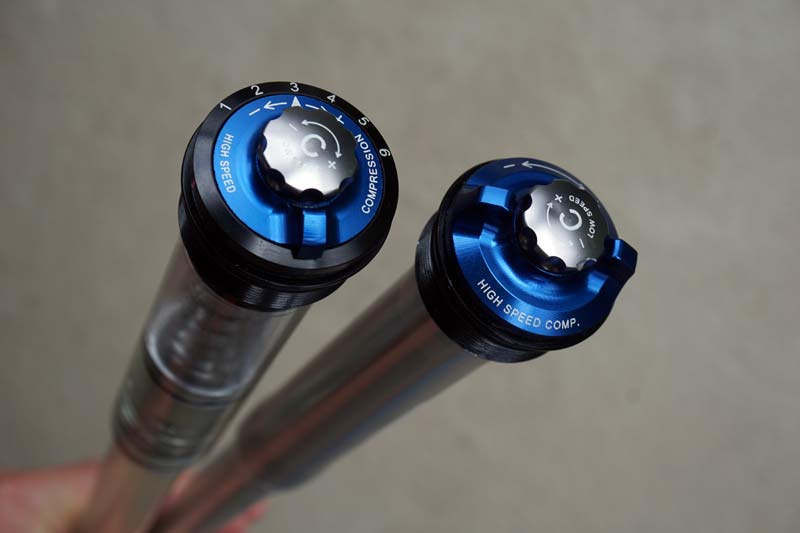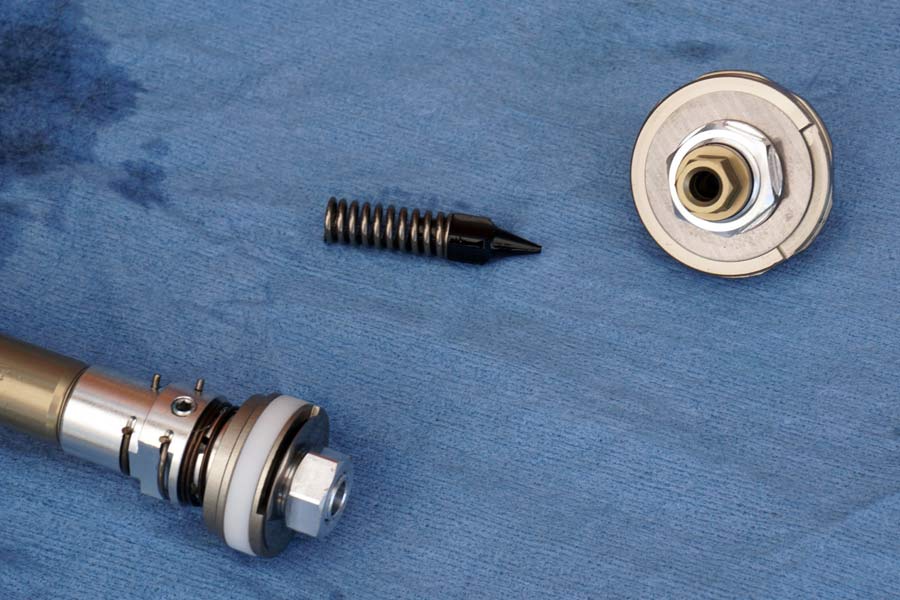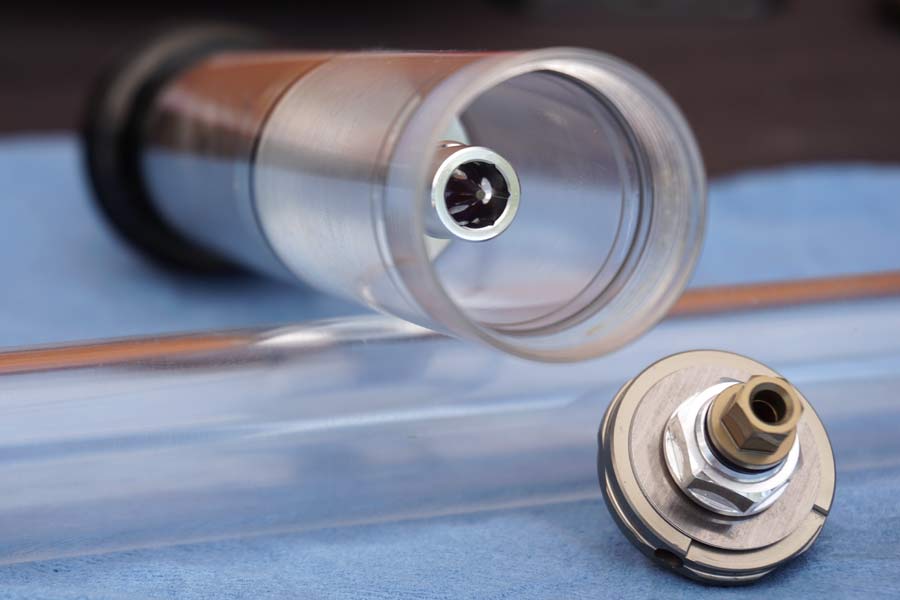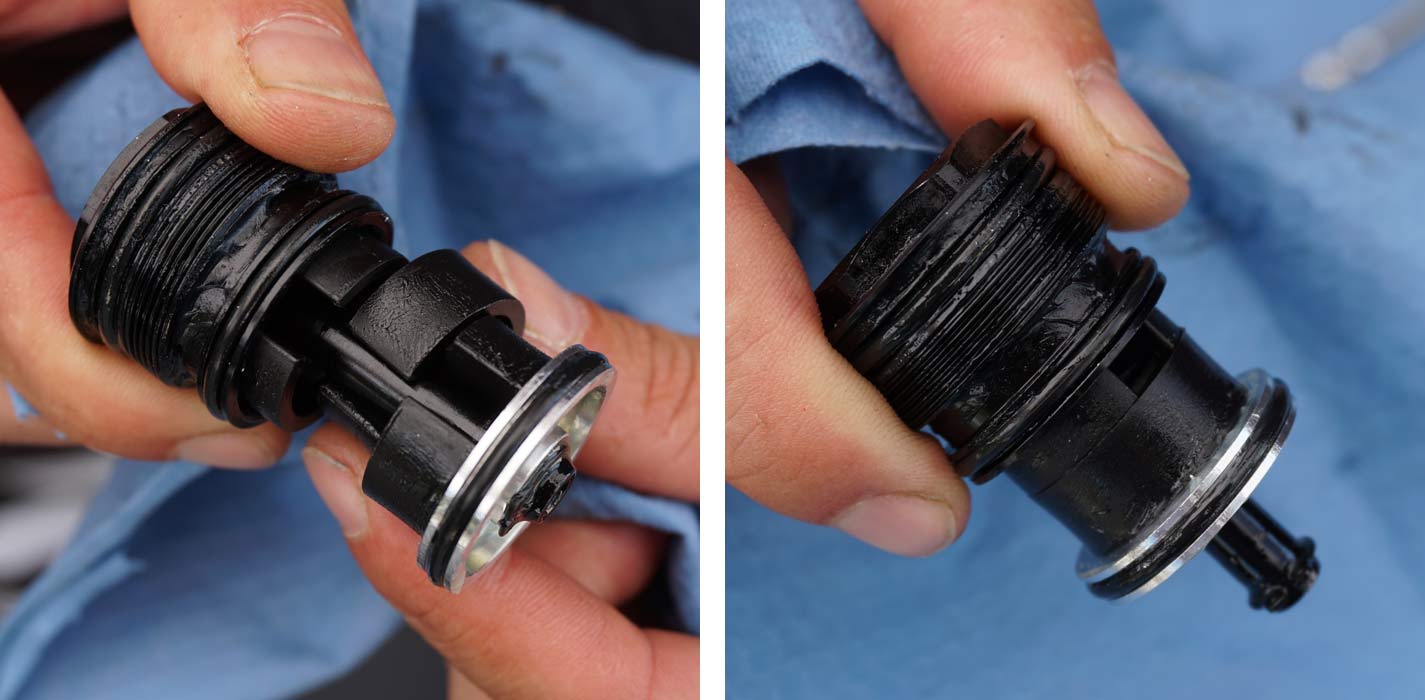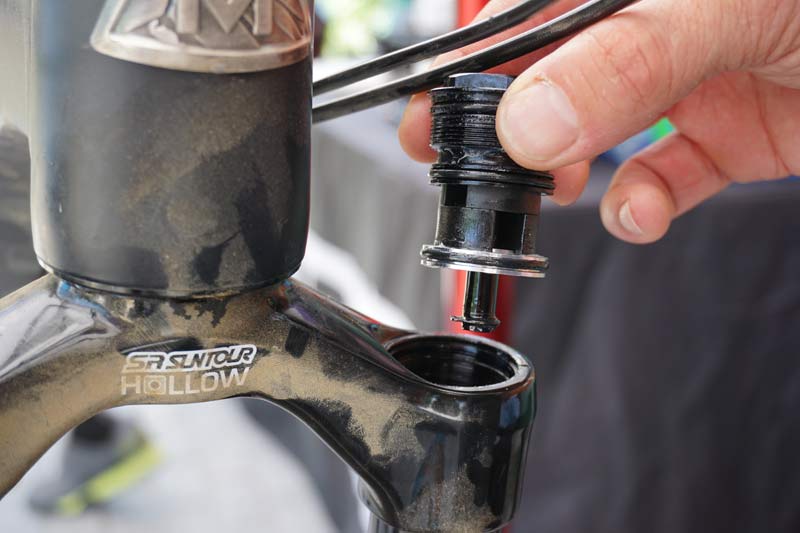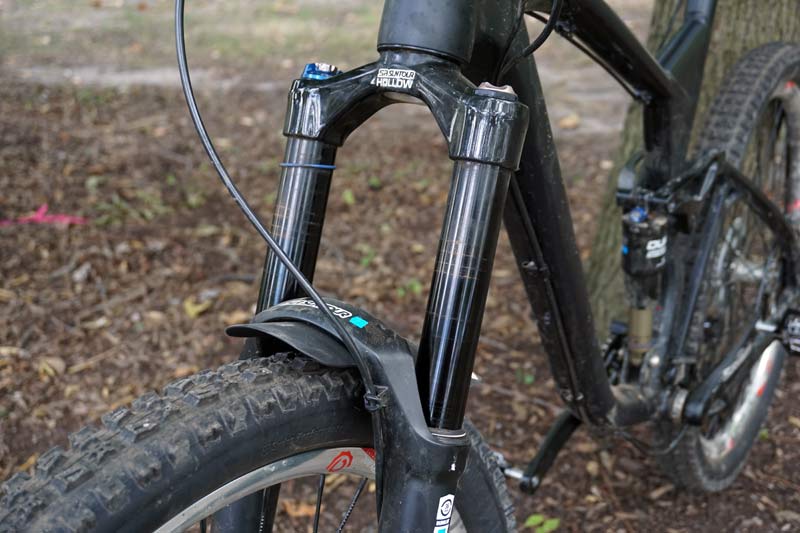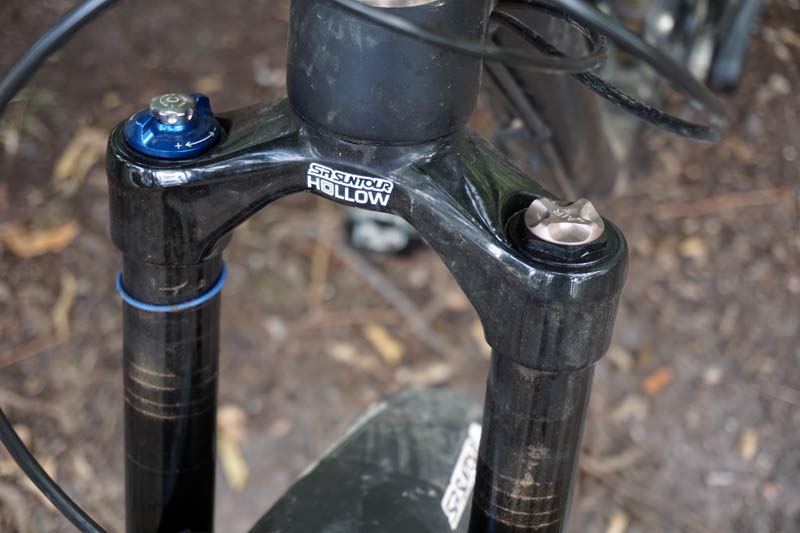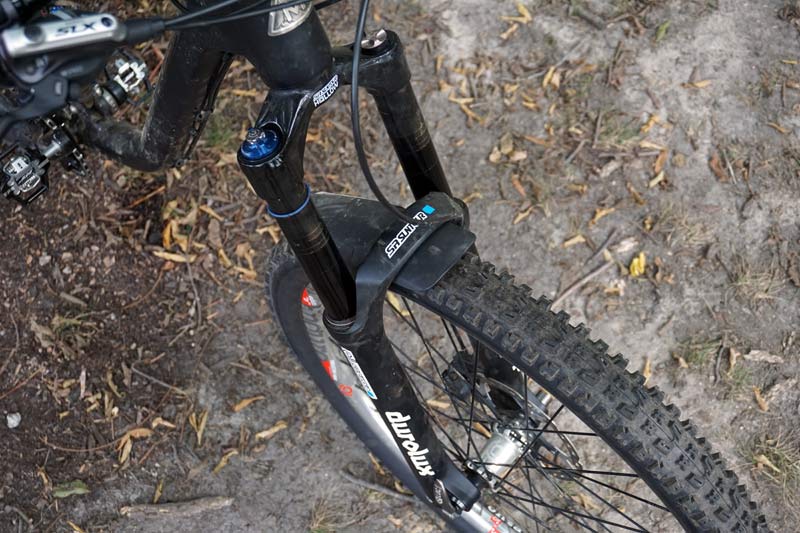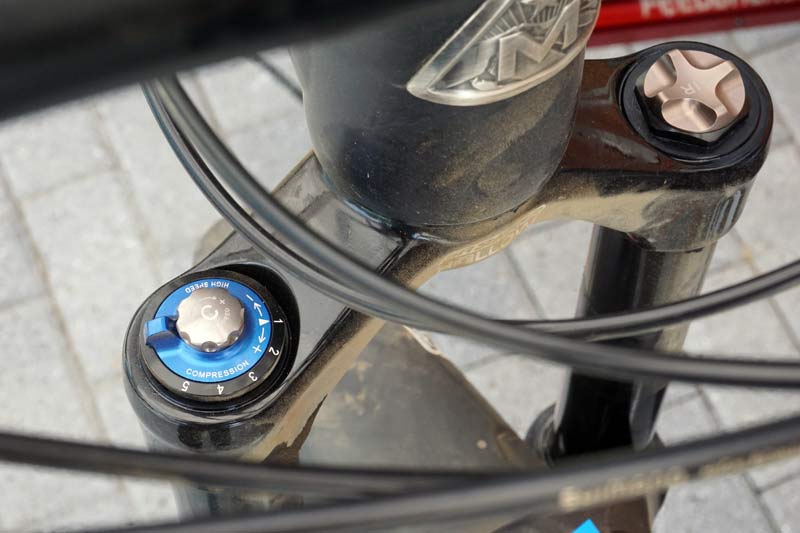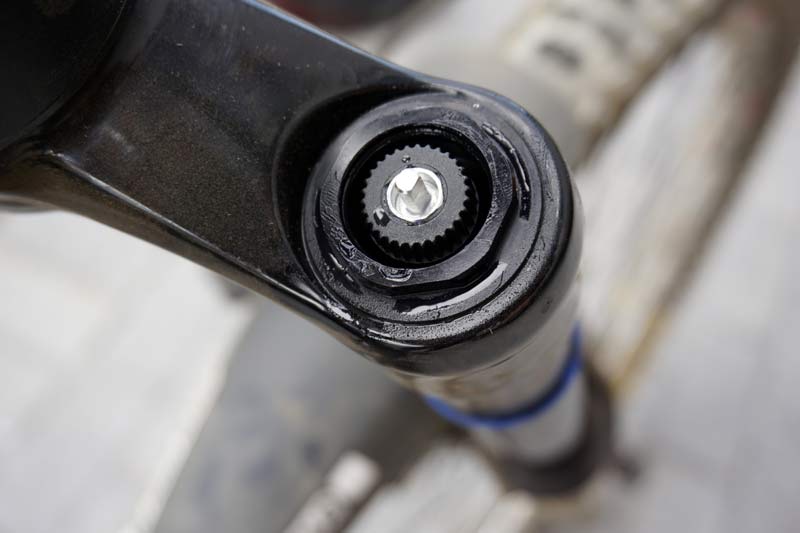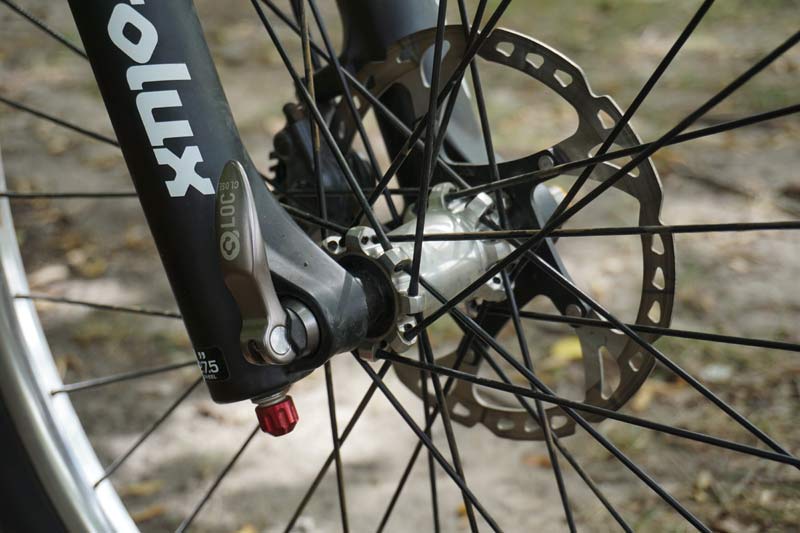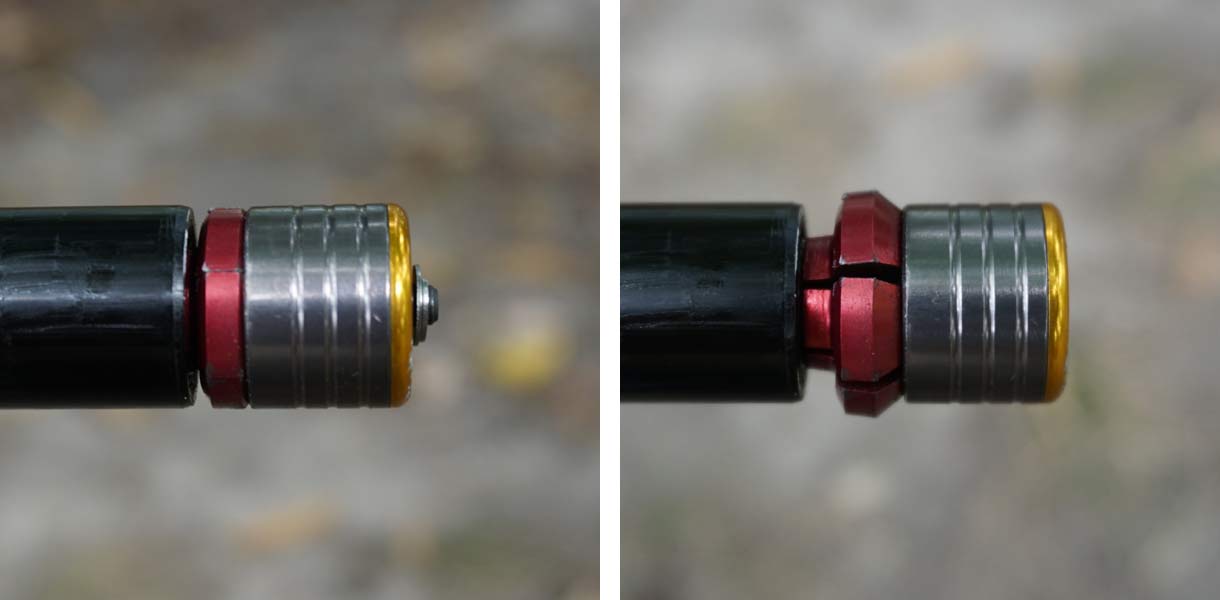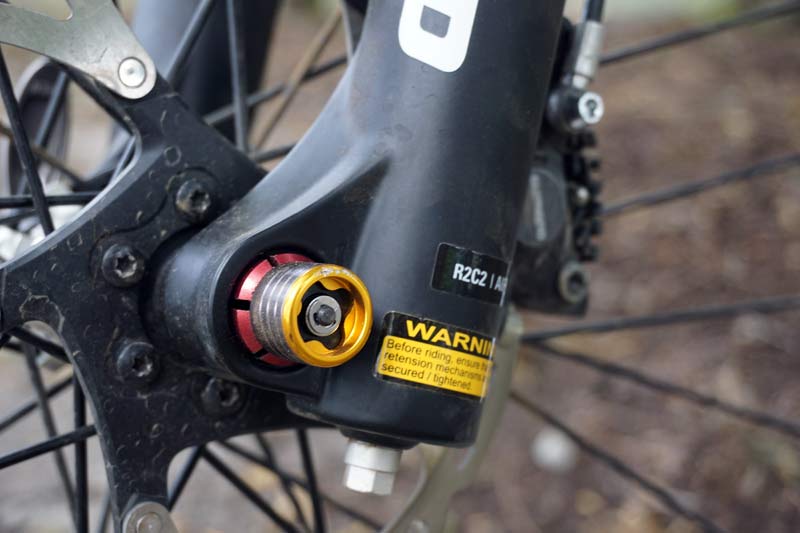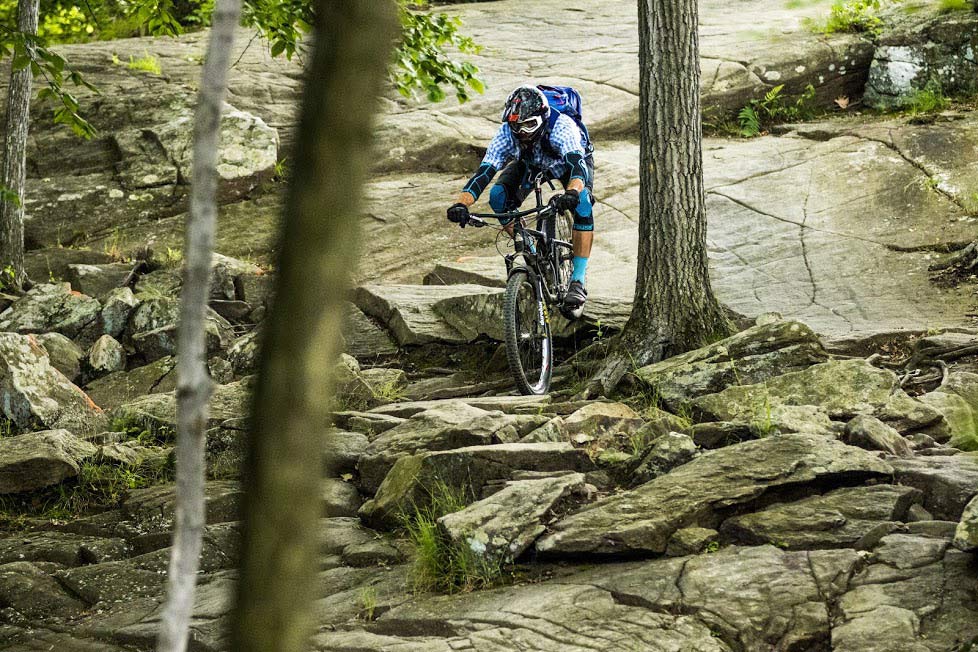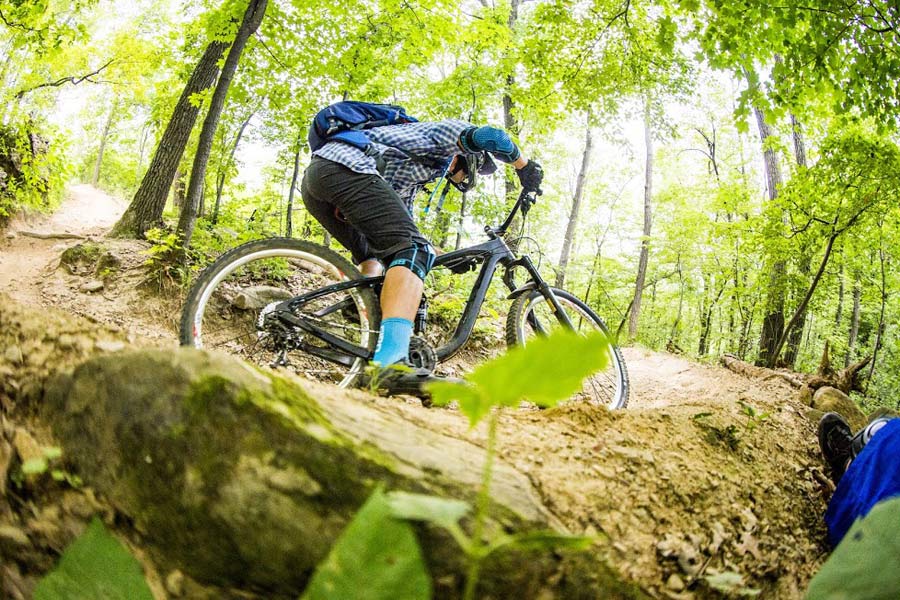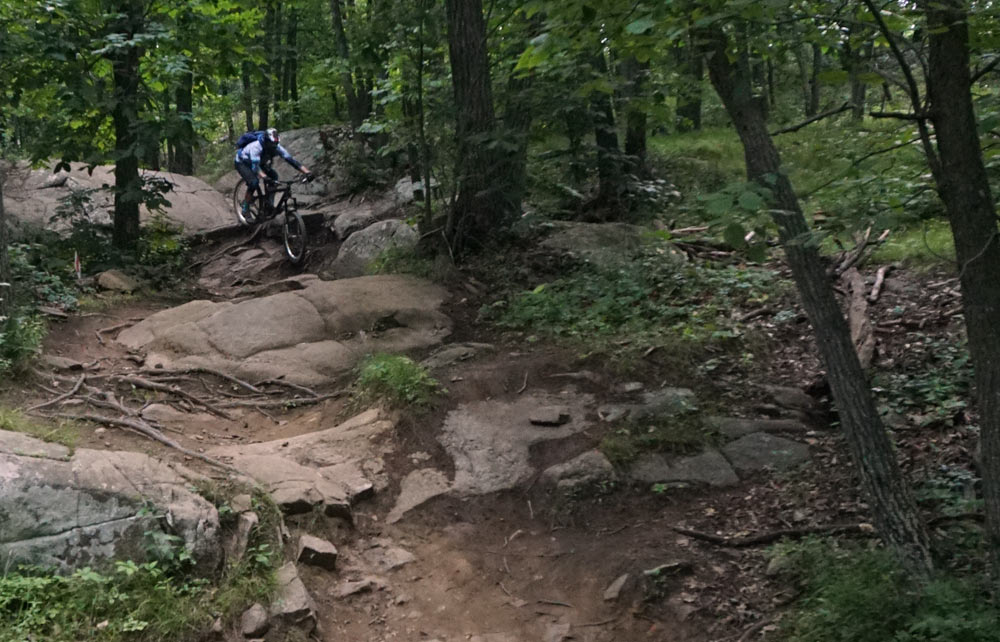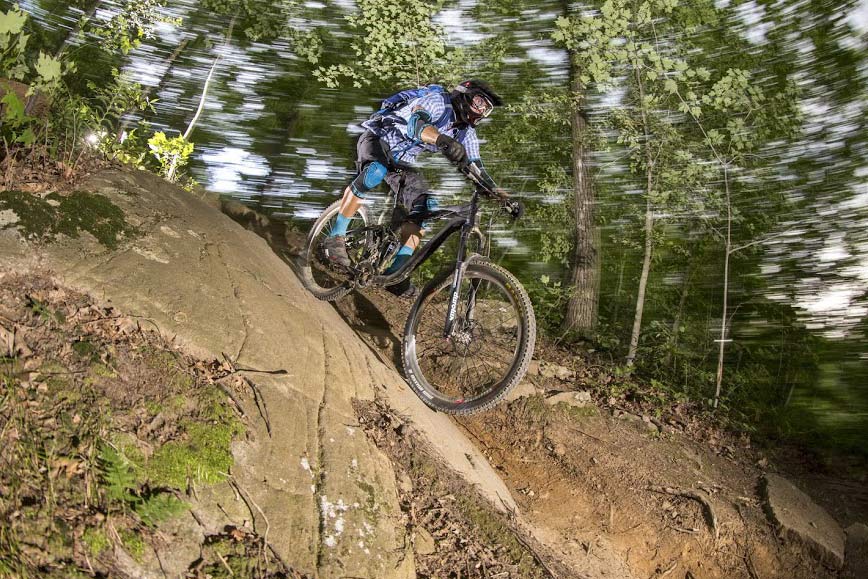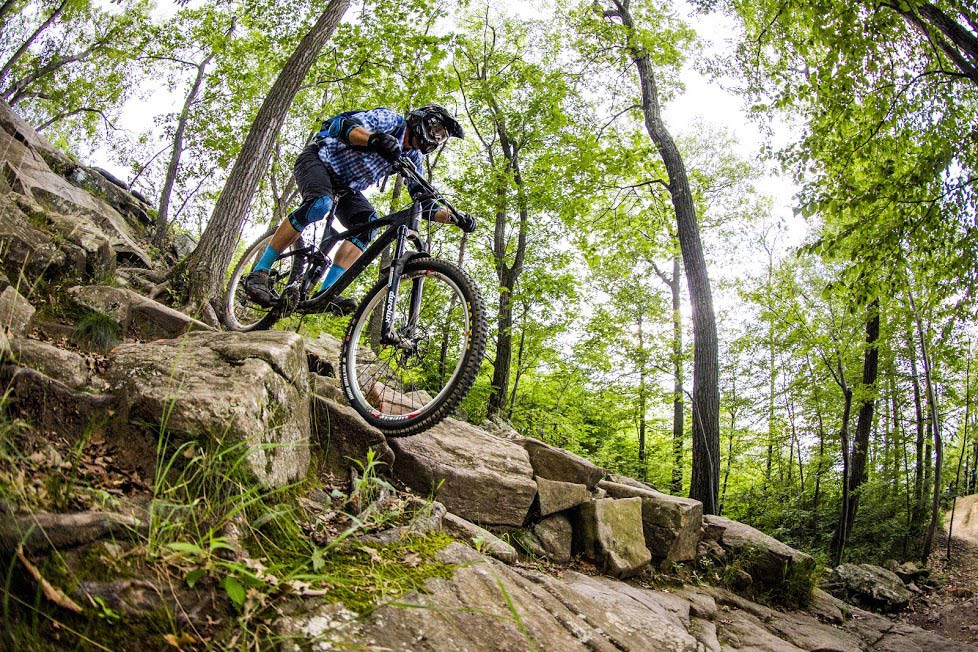Compared to the prior model, the all-new 2016 SR Suntour Durolux fork is a beast. It’s bigger, blacker and has an impressive new cartridge damper that gives you complete control over virtually every performance facet you could want. We’re gonna dive deep, so first, a little background…
In 2001, the brand switched all high end forks to a closed cartridge systems to simplify things and make the products easier to service. They call it QSP (Quick Service Product) and Cartridge Science, which basically means if something goes wrong, you just swap in a new cartridge to fix it.
SR Suntour sponsors a lot of top riders in the EWS and downhill circuits, so they had plenty of World Cup level riders to push the products to the limits. As mountain biking has gotten faster and faster over the past few years, they had to take a fresh look at their damper cartridge so it could keep up. Thanks to feedback from riders like Kyle Warner, James Doerfling, Remy Absalon, Garett Buehler, Brett Tippy, Mike Hopkins and the Voul Voul Racing Team’s young up and comers, they identified created a list of goals for a new fork…
CHALLENGES & GOALS
In order to up the game on modern long travel forks for enduro, all-mountain and freeride, the new Durolux had to see the following improvements:
1) Compression range in high speed conditions couldn’t cavitate. Cavitation is when microscopic air bubbles are put under enough pressure to form larger bubbles, which can’t be damped and causes the fork to lose control, however briefly. In an open system or in SR Suntour’s prior cartridge, which used an emulsion damper (more on that in a minute), air could mix easily with the oil, and as piston speed inside the cartridge tops 4 m/s (meters per second), cavitation occurs.
2) high speed recovery over rapid succession hits needed to be better.
3) rebound couldn’t kick back
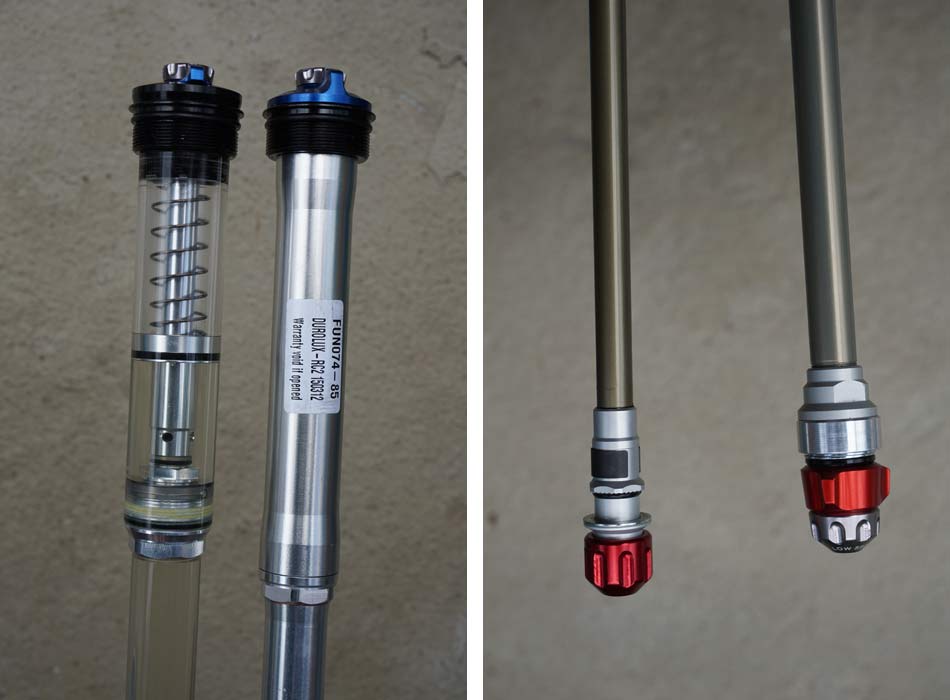
Other brands have turned to a bladder system in their forks, which creates a closed cartridge that relies on a flexible membrane to handle the oil as compression pushes oil through the system. In their testing, SR Suntour found that no matter how good the bladder was, those types of systems will always eventually require bleeding, which basically means you need to replace the cartridge…it’s not a user friendly process.
SOLUTIONS, UPDATES & TECH
Their solution was the PCS (Piston Compensator System), which is an IFP (Internal Floating Piston) between the oil overflow reservoir and the air-filled space at the top of the cartridge. It’s backed with a light coil spring to help push back against the oil, which helps move it back through the rebound circuit. They chose a light spring rather than a nitrogen charge, which is what’s commonly used behind the IFP in virtually all rear shocks, because it wouldn’t require such a tight seal at the IFP. The nitrogen charge in a shock typically has 2.5x to 3x the pressure of the oil, which can put up to 15bar of pressure on the IFP’s O-ring. That setup is required for shocks because rear suspensions are often operating at a higher leverage ratio. Because we’re talking about a fork, though, the ratio of hit to travel is 1:1. So you don’t need that back pressure, and the light spring works. That means less friction in the system for better overall performance.
It also marked the switch from a emulsion damping system where there was no IFP separating the oil from the air. This pushed their cavitation rating from around 4m/s (meters per second piston speed) all the way up to about 9m/s. Which is something a World Cup winning DH run might experience once per run, maybe. You and me? Possibly never.
The end goal of all of that design work was to improve consistency over long duration, high speed descents and give them something that could compete at the highest levels.
Another upgrade on the new R2C2 damper (left) is that it includes external high and low speed compression and rebound damping controls. The original RC2 has high/low compression, but only low speed rebound.
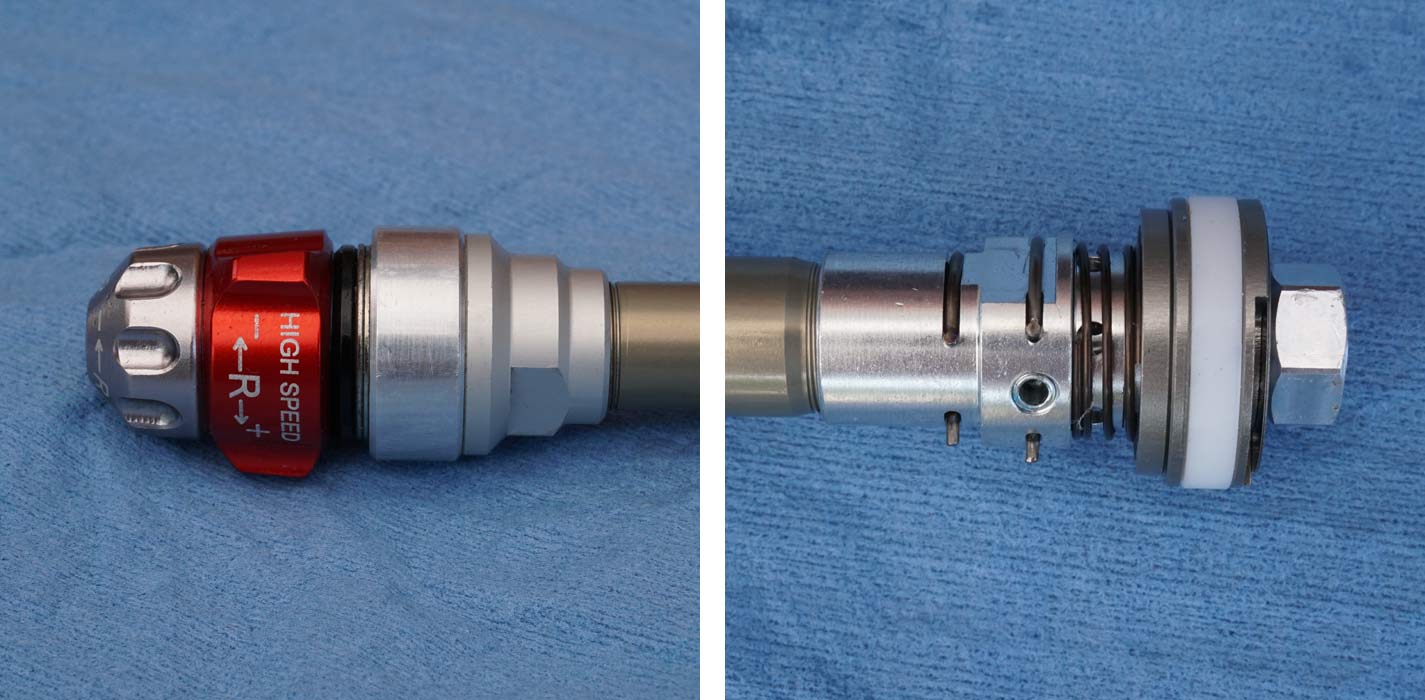
Virtually all forks these days have Low Speed rebound adjustment, which lets you set the rebound rate felt in the top two thirds of travel (beginning stroke). Those forks set the High Speed rebound properties at the factory, which controls how quickly the fork returns from the last third of your travel (end of stroke) into the middle of the stroke. Generally you want this to be pretty quick so the fork doesn’t have to take a second hit while fully compressed, but then slow down so it doesn’t bounce you all the way back up and make you lose control. With the new R2C2 damper, you get external control over both, letting you really dial the system to your riding style and terrain.
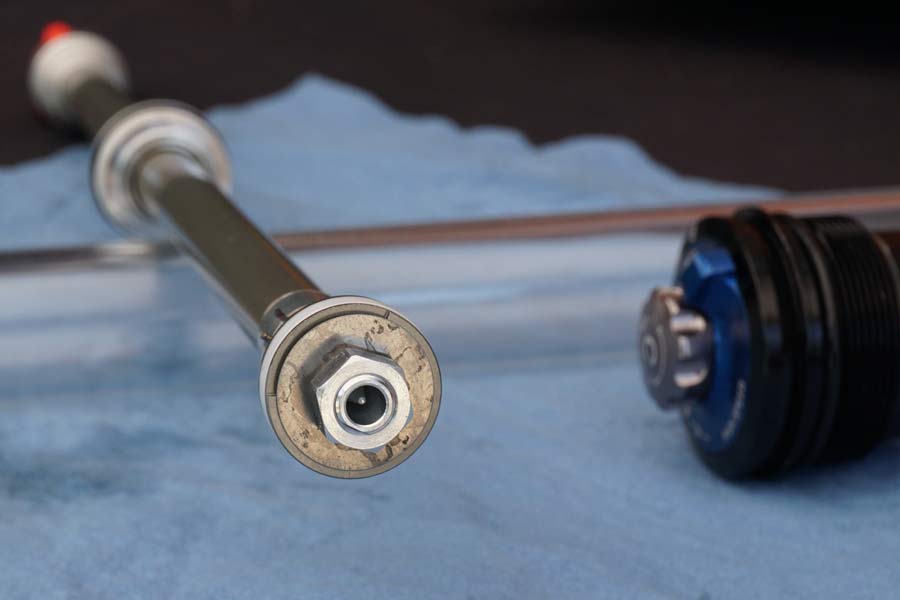
The High Speed rebound damping is a shim-and-port based system with four clicks of adjustment, and it sits on top of the orifice-based low speed rebound circuit, which has 18 clicks of adjustment. Combined, you can find the right blend to keep the fork under control and staying in that sweet spot of travel when you get into sections with repeated hits.
For Compression, they’ve updated the high speed circuit with a new shim stack that gives them much more control over big hits. Six clicks open or close the high speed ports. The old RC2 damper used a wider range blow off valve, so on big hits it could easily overpower the system and send too much of the force to the handlebars. Think of it as jumping from 0 to 1. The new shim stack let them divvy that force up into increments of 0 to 0.1 to 0.2 to 0.3 and so on. The end result is that it controls impact forces so that much, much less of it reaches the handlebars.
Low Speed compression is a spring loaded needle poking into the primary orifice. Turning the adjustment moves it in or out to adjust flow speed. The spring-loaded design allows it to blow open under severe impact.
They designed the circuits so that each click made a noticeable change in performance, so you’re not stuck with a bunch of clicks that do nothing.
Another adjustment available is air volume. The forks come with three pucks inside the air spring, giving you four total options (0, 1, 2, or 3 pucks) for tuning the progression of the fork. Check out our Suspension Setup Series for a primer on how all of these adjustments affect your ride.
Travel reduction is done with spacers, so the fork starts out as a 180mm fork that can be dropped down in 10mm increments to 170mm or 160mm. Technically you could drop it all the way down to a 100mm fork and use it for dirt jump, but it would be a very heavy, very overbuilt DJ fork. The beauty of the system is an excellent application of their QSP philosophy: The travel spacers are the same pucks used for air volume adjustment. Brilliant.
Housing all of these new damping and adjustment updates is a completely new chassis. Compared to the existing 26″ Durolux forks, this one grows 1mm to have 36mm stanchions and will fit 27.5″ wheels only. And the stanchions are now shiny black, which they admit is mostly for aesthetics.
All of their forks use a dual stage coil negative spring with a heaver anti-top out spring and a longer, lighter weight true negative spring that helps you dial the ride in. They’re working on aftermarket negative spring options for lighter riders.
Under the dust wiper is a foam ring that’s saturated with oil and can be topped off with the Lubrification port, a small grease port on the backside of the fork, just below the wiper seal. The ports are mainly for pressure relief, even though they’re called “Lubrification” ports. You can use up to 1cc of oil at a time to keep the seals and wipers moist, but they recommend no more than five such refills before you pull the fork apart to drain the old oil from the bottom and service the fork.
Under that is a metal-backed Teflon slotted bushing that allows it to hold the factory installed grease to lube the stanchions. Self servicing it with up to 1cc of oil in the lube ports can be done up to five times, at which point the lowers should be pulled to drain it all and have the fork serviced. If too much oil is splashing around in the lowers, it can get sucked into the cartridge and cause things to freeze up.
SR Suntour’s Cartridge Science design means the damping cartridge can easily be replaced, removed for factory service or upgraded. The adjustment knobs pry off…
…revealing the hex shaped head, which you remove with a giant socket and pull the entire cartridge out. It also gives you access to the only real user adjustment available: If you think cavitation has occurred, you can remove any bubbles from the damping oil by simply opening the top of the cartridge, removing the small screw from the IFP and compressing it slowly and slightly until any air bubbles have been purged, then replace the screw and reassemble everything. It’s very similar to bleeding a set of brakes.
The new Durolux uses a 20mm thru axle only. There’s talk of making reducers to fit 15mm axles, but don’t hold your breath. It uses the QLOC2 thru-axle system, which is both simple and quick.
To remove the wheel, open the lever and push the other end in to compress the red flange. That lets the skewer slide out.
When you slide it back in, just give the collet a quarter turn and the flanges pop back out and then you close the lever. It’s a nice dual-release system that reduces the likelihood of the skewer coming loose and removing itself mid-ride. Twist the silver end to adjust the final clamping force of the skewer.
Last but not least, it also comes with that sweet fender pre-installed. Full specs are:
- 2016 Durolux 27.5″
- Lubrification holes
- Air volume spacers
- Internally adjustable travel 160-180mm
- Integrated mud guard
- 20mm QLOC2
- Hollow forged crown
- Black hard ano stanchion coating
- 2,337g claimed with R2C2, thru axle and uncut tapered steerer
- $800 with R2C2
- Available in December 2015
The new chassis is also be available with the original RC2 cartridge for $700, and those are shipping now.
The new fork’s weight is a bit heavier than the old Durolux, but these jump to 36mm stanchions versus 35mm, and they become 27.5” forks rather than 26” forks (the lowers are about 10mm taller than before). So, apples and oranges, really.
No plan for a 110mm Boost spacing on this model for now, but they offer other models with that spacing already or are coming soon. The 26” RC2 Durolux will stay in the line, and those models might see some of these updates in the near future, but nothing’s confirmed yet.
FIRST RIDE IMPRESSIONS
SR Suntour invited us to the wicked Mountain Creek Bike Park in New Jersey this summer to test the new Durolux with R2C2 damper and the new rear shocks. I brought the enduro-proven Marin Attack Trail and Industry Nine Enduro alloy wheels. Having scoped the place out online first, I also brought some Bliss Protection knee and elbow pads and a Kali full face helmet to, um, test.
Mountain Creek offered the perfect blend of sweeping bank turns, rock gardens, berms, rock gardens, high speed connectors, and more rock gardens. Thrown in plenty of jumps and drops and the trails will let you be as aggressive as you dare. Many a tire was sacrificed during our testing…the Schwalbes that came on the Marin were destroyed in the first few runs. So, most of us ended up running tubes and much higher pressures than normal (40+ psi) to avoid pinch flats and rim crushing dings.
That meant virtually all of the traction and bump absorption was left up to the suspension. Fortunately, the new Durolux was up to the task.
Whether it was a something like this drop-root-roller-rocks-drop-lip-more rocks-drop combo or a steep, technical descent or worse, the fork held its own. The fatter legs and 20mm thru axle directed the front wheel where I pointed it, which instills the confidence necessary to rip through trails like this. Others were certainly faster than me, but I was able to push past my own comfort zone without any equipment failures making me wish I hadn’t.
I had a day and a half on the new fork, and most of that time was with a preproduction R2C2 damper installed. Halfway through the day two, my and a couple others’ cartridges started leaking and were replaced with RC2 dampers. It’s only fair to say these were definitely preproduction, so the leaking is something not likely to occur in the final versions that go into production late this October (they’re supposed to start shipping from the factory in November, available at retail by end of year). But, it does mean my time on the new damper was limited and largely ridden with excessive tire pressure. With those caveats in mind, I’d still recommend checking the new Durolux out when it hits stores.
My test fork came home with me (with the RC2 damper) and has been ridden on local Greensboro, NC, trails for a couple months. It’s begging for trips to Pisgah and Roanoke, but weather, trade shows and other travel mean that’ll come later, as will a long term review once we get the a replacement R2C2 damper to drop in.
From the standpoint of features and technical updates for the price, SR Suntour has moved into the big leagues. Compare the adjustments and attributes to anything else on the market and it stacks up quite favorably. It also looks great, and so far it rides great. Stay tuned…
Need a new shock for the rear? Check out the completely revamped UnAir and DuAir shocks that launched this summer.
